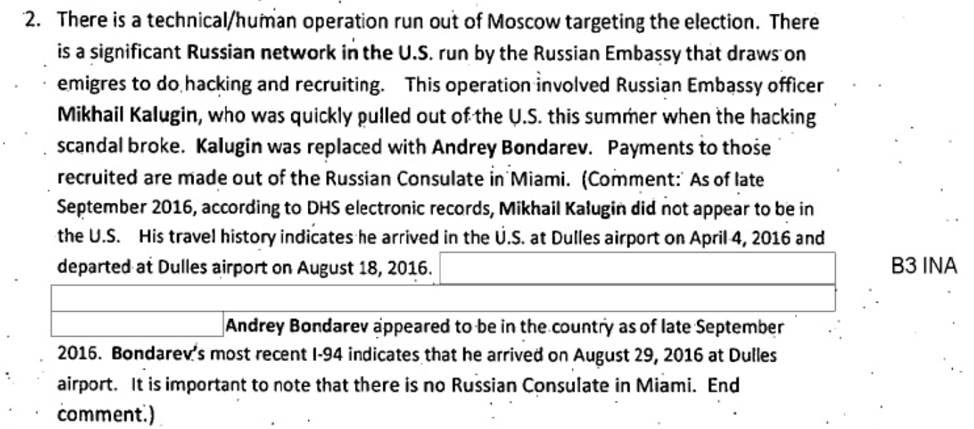
In October 2016, the Obama administration’s Department of Justice (DOJ) obtained the first of four Foreign Intelligence Surveillance Act court surveillance orders on former Trump campaign advisor Carter Page. More than a year later, and following an intensive investigation into the FISA process by the House Permanent Select Committee on Intelligence (HPSCI), Rep. Devin Nunes (R–Calif.) released a four-page memorandum detailing FISA abuse related to the Page surveillance order.
Since then, there has been a constant stream of evidence exposing the abuse. The most recent addition came last week when news broke that Deputy Assistant Secretary of State Kathleen Kavalec met with dossier author Christopher Steele on October 11, 2016—two weeks before the DOJ and FBI relied on the Steele dossier to obtain a FISA surveillance order targeting Page.
Notes Kavalec took memorializing her meeting with the former MI6 spy, and reports that Kavalec shared with the FBI details of her confab with Steele, provide more proof that Obama administration officials and career DOJ and FBI employees abused the FISA court process.
Ample Evidence of FISA Abuse
Kavalec’s notes provide at least four more pieces of proof to the already conclusive case of FISA abuse. First, as John Solomon highlighted at The Hill, the FISA application stated the FBI had determined Steele to be “reliable” and was “unaware of any derogatory information pertaining” to their source, while Kavalec’s memorandum showed just the opposite—that Steele was not reliable.
In her notes, Kavalec wrote that Steele claimed “the Russians had constructed a ‘technical/human operation run out of Moscow targeting the election’ that recruited emigres in the United States to ‘do hacking and recruiting,’” and that “payments to those recruited are made out of the Russian Consulate in Miami.” But in Kavalec’s log of her meeting with Steele, she corrected his “intel,” writing: “It is important to note that there is no Russian consulate in Miami.”
Second, Kavalec’s meeting notes prove that Steele lied to the FBI and that the FBI, in turn, lied to the FISA court. The FISA application stated that Steele “told the FBI that he/she only provided [the results of his research] to [his] business associate and the FBI.” But in her notes, Kavalec wrote that in “June—reporting started,” and the “NYT and WP have,” indicating both The New York Times and The Washington Post had Steele’s research. Kavalec also added that Steele said he was “managing” four priorities—“Client needs, FBI, WashPo/NYT, source protection.”
Yet, according to the FISA application, Steele maintained he only provided the opposition research to the FBI and his business associates. That assertion conflicts with Kavalec’s notes of her conversation with Steele. The FBI nonetheless attested to the FISA court that Steele was “reliable.”
Third, as Kavalec documents in her notes, Steele stated that his client was “keen” that his anti-Trump research be made public before Election Day. This detail further illustrates the purely political nature of Steele’s supposed intel, yet the DOJ and FBI withheld this detail from the FISA court.
Failure to Conduct Even Rudimentary Screening
Fourth, and finally, Kavalec’s notes from her meeting with Steele expose the FBI’s failure to conduct even a rudimentary screening of Steele’s supposed intel before relying on it in the FISA application. In her talk with Steele, her notes say he identified two Russians involved in the hacking scandal: Mikhail Kalugin and Andrey Bondarev. Steele claimed that Kalugin was quickly pulled out of the United States in the summer of 2016 and replaced with Bondarev.

So what did Kavalec do with this information? Did she take Steele at his word? No, she checked “DHS electronic records” to determine when the individuals entered and left the country!
Yet when Steele claimed in his dossier that Trump attorney Michael Cohen had traveled to Prague to discuss “how deniable cash payments were to be made to hackers who had worked in Europe under Kremlin direction against the CLINTON campaign and various contingencies for covering up these operations and Moscow’s secret liaison with the TRUMP team more generally,” the FBI apparently took Steele at his word. At least, we’ve yet to hear of the FBI attempting to corroborate this detail, and we know that Special Counsel Robert Mueller concluded the Prague trip never happened.
That Kavalec knew these facts does not necessarily mean the individuals who drafted, approved, and attested to the FISA application did. But we know that shortly after her meeting with Steele, Kavalec emailed the FBI, and sources confirmed to Solomon that Kavalec forwarded some details about her conversation with Steele to her FBI contact, who in turn “immediately forwarded the information he received about Steele on Oct. 13, 2016, to the FBI team leading the Trump-Russia investigation, headed by then-fellow Special Agent Peter Strzok.”
We may not know for some time exactly what Kavalec told her FBI contact, but frankly, it doesn’t matter. Once the FBI knew Steele had spoken with Kavalec, agents should have reached out to Kavalec to learn the full extent of her conversation with Steele. That conversation would have established that Steele had misled the FBI and that his intel was not reliable and should not be included in the FISA application. In other words, the DOJ and FBI abused the FISA court system.









